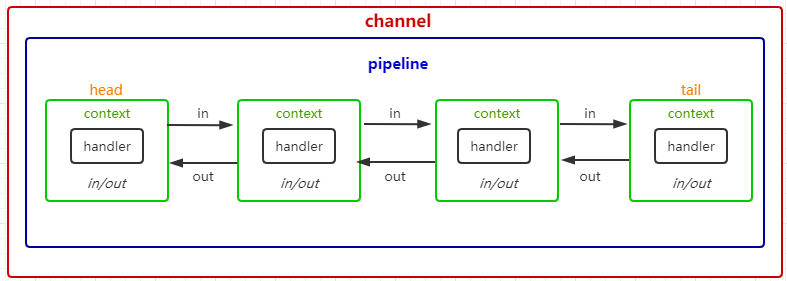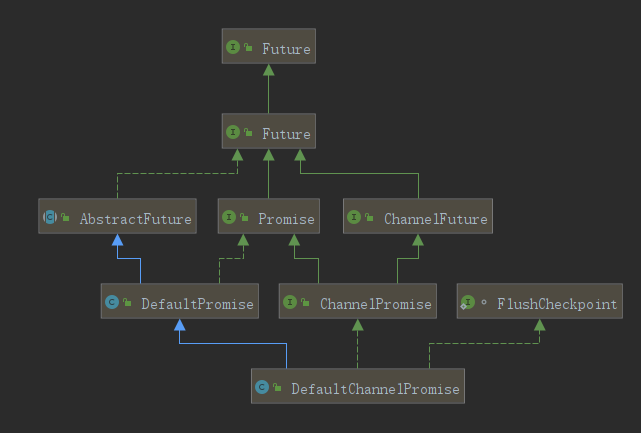netty核心组件之channel、handler、ChannelHandlerContext、pipeline
channel介绍:
netty中channel分为NioServerScoketChannel和NioSocketChannel,分别对应java nio中的ServerScoketChannel和SocketChannel

channel、pipeline、context、handler关系
ScoketChannel都会注册到EventLoop上的selector中,每个channel内部都会有一个pipeline,pipeline管道 里面由多个handler连接成一个双向链表结构,而handler又由ChannelHandlerContext包裹着,context相当于一个handler上下文,做到了承上启下的作用,
从context可以得到handler,自然也能得到channel和pipeline,context内部有两个指针分别指向前 后context,handler在pipeline向前或向后进行传递,当然顺序只能由一个方向传递

head和tail表示头尾,每一次有io事件进入,netty称为入站 它始终从head入站像后进行传递,反之io事件出去称为出站,也是从head出去,图中入站出站看似形成了一个完整的双向链表,但实际可能还没到tail就结束了,
context分为inbound和outbound,入站和出站会判断当前context是否符合 也是判断context中handler是inboundhandler还是outboundhandler,入站只执行入站的context,出站也是如此,在初始化pipeline会默认创建head、tail,
它们分别表示头 尾 位置固定不许修改,head和tail同时为inbound、outbound
先来看看handler是如何先加入pipeline中的,handler添加顺序无论怎么添加,头都是head 尾都是tail pipeline初始化就固定了
bossGroup.childHandler(new ChannelInitializer<SocketChannel>() { @Override public void initChannel(SocketChannel ch) throws Exception { ChannelPipeline p = ch.pipeline();
// 像pipeline添加一个handler p.addLast(new EchoServerHandler()); } });
// 将context添加到pipeline的"最后"
private void addLast0(AbstractChannelHandlerContext newCtx) {
AbstractChannelHandlerContext prev = tail.prev;
newCtx.prev = prev;
newCtx.next = tail;
prev.next = newCtx;
// 重新指向 依然保持着 tail》context》tail
tail.prev = newCtx;
}
在创建ServerBootGroup时会给workerGroup分配一个handler,后面每一个NioSocketChannel都会添加一个该handler, ChannelInitializer可以理解为帮助我们创建channel,它是一个inboundhandler,在第一次注册时会调用initChannel来执行我们自定义的实现
public final void channelRegistered(ChannelHandlerContext ctx) throws Exception {// 这里会调用我们实现的initChannel方法,并把ctx中的channel传过去 if (initChannel(ctx)) { // 初始化成功,这里就是我们入站的入口了,它是从pipeline发起的 ctx.pipeline().fireChannelRegistered(); } else { // 如果已经初始化过了,说明已经进入pipeline了,直接向后传递 ctx.fireChannelRegistered(); } }
下面分别列举ChannelInboundHandler和ChannelOutboundHandler的方法让大家知道哪些是入站执行的,哪些是出站执行的
public interface ChannelInboundHandler extends ChannelHandler { // 注册 void channelRegistered(ChannelHandlerContext ctx) throws Exception; // 取消注册 void channelUnregistered(ChannelHandlerContext ctx) throws Exception; // 处于活动状态 void channelActive(ChannelHandlerContext ctx) throws Exception; // 处于非活动状态 void channelInactive(ChannelHandlerContext ctx) throws Exception; // 读取数据 void channelRead(ChannelHandlerContext ctx, Object msg) throws Exception; // 读取数据完毕 void channelReadComplete(ChannelHandlerContext ctx) throws Exception; // 用户自定义事件触发,如发生心跳检测时,会调用该方法把当前心跳事件传播进来 void userEventTriggered(ChannelHandlerContext ctx, Object evt) throws Exception; // channel可写状态改变 void channelWritabilityChanged(ChannelHandlerContext ctx) throws Exception; // 发生异常 void exceptionCaught(ChannelHandlerContext ctx, Throwable cause) throws Exception; } public interface ChannelOutboundHandler extends ChannelHandler { // 绑定 void bind(ChannelHandlerContext ctx, SocketAddress localAddress, ChannelPromise promise) throws Exception; // 连接 void connect(ChannelHandlerContext ctx, SocketAddress remoteAddress, SocketAddress localAddress, ChannelPromise promise) throws Exception; // 断开连接 void disconnect(ChannelHandlerContext ctx, ChannelPromise promise) throws Exception; // 关闭 void close(ChannelHandlerContext ctx, ChannelPromise promise) throws Exception; // 注销 void deregister(ChannelHandlerContext ctx, ChannelPromise promise) throws Exception; // 暂时不知道这一步干啥的,按理说read操作是入站操作 void read(ChannelHandlerContext ctx) throws Exception; // 写 void write(ChannelHandlerContext ctx, Object msg, ChannelPromise promise) throws Exception; // 刷新刚执行的操作 void flush(ChannelHandlerContext ctx) throws Exception; }
还有一个特殊的handler ChannelDuplexHandler,它同时继承ChannelInboundHandler和ChannelOutboundHandler,但不推荐用它,容易混淆,建议我们自己写的时候把入站和出站的handler分开
public class ChannelDuplexHandler extends ChannelInboundHandlerAdapter implements ChannelOutboundHandler
ChannelHandlerContext传播行为
前面我们讲入站是像后进行事件传递,出站是向前进行事件传递,那么事件入口是如何进来的、怎么出去的,怎么保证执行的顺序
如读事件,发生read事件时,会交给NioUnsafe方法,Unsafe随后会有介绍 它是netty中用来操作jdk中的nio,因为事件操作还是都交给jdk中的nio来,读取数据时会调用pipeline.fireChannelRead(readBuf.get(i)),这样就进入pipeline了 来开始事件传播
private final class NioMessageUnsafe extends AbstractNioUnsafe { @Override public void read() { ~~~~~~~~~~~~~ int size = readBuf.size(); for (int i = 0; i < size; i ++) { readPending = false; // >>>>>>>>>进入入站读操作 pipeline.fireChannelRead(readBuf.get(i)); } readBuf.clear(); allocHandle.readComplete(); // 完成操作 pipeline.fireChannelReadComplete(); ~~~~~~~~ } }
pipeline开启事件传播
// 调用pipeline该方法开始事件传播 public final ChannelPipeline fireChannelRead(Object msg) { AbstractChannelHandlerContext.invokeChannelRead(head, msg); return this; } // >>>AbstractChannelHandlerContext.invokeChannelRead(head, msg) 由pipeline调用 然后进入context事件传递 static void invokeChannelRead(final AbstractChannelHandlerContext next, Object msg) { final Object m = next.pipeline.touch(ObjectUtil.checkNotNull(msg, "msg"), next); EventExecutor executor = next.executor(); // 判断是否在当前线程,如果在当前线程直接调用,否则当成任务交给executor执行 if (executor.inEventLoop()) { next.invokeChannelRead(m); } else { executor.execute(new Runnable() { @Override public void run() { next.invokeChannelRead(m); } }); } } private void invokeChannelRead(Object msg) { // 判断handler是否已经被调用 if (invokeHandler()) { try { /** * 调用handler的读操作,用户通过实现该方法完成自定义读事件逻辑,如果读取完后需要向后传递,需要在channelRead自定义方法中继续调用context.fireChannelRead(msg) * **/ ((ChannelInboundHandler) handler()).channelRead(this, msg); } catch (Throwable t) { notifyHandlerException(t); } } else { // 已经被调用 调过当前handler向后传递 fireChannelRead(msg); } } public ChannelHandlerContext fireChannelRead(final Object msg) { // 找出下一个入站handler继续向后传递 invokeChannelRead(findContextInbound(), msg); return this; } private AbstractChannelHandlerContext findContextInbound() { AbstractChannelHandlerContext ctx = this; // 不停地获取下一个handler直到是inboundhandler返回 do { ctx = ctx.next; } while (!ctx.inbound); return ctx; }

这就是读数据入站的大致传播流程,从head入站直至tail或中途停止事件传播, 出站流程类似 我就不贴了
在讲解服务端和客户端启动流程前我们还需要再熟悉几个重要类
ChannelFuture、Promise、Unsafe
我们先来channelfuture和promise的继承结构

- ChannelFuture:nio既然是异步执行的,那么必定有异步执行结果,跟线程池一样,netty也对应有一个future
- Promise:Promise也继承于future,听起来是不是和channelfuture功能重复了是不是,它两主要区别是,channelfuture可以得到对应的channel,promise可以主动设置异步执行状态,实际使用的ChannelPromise的实现类DefaultChannelPromise,channelPromise又同时继承channelfuture和实现promise,我个人不太理解为啥有channelfuture还多设计一个promise,直接在channelfuture加一个设置异步状态的接口不就好了,我猜想可能是promise可以当做一个脱离channel普通的异步实现,优秀的框架内部“果然都是可高度自定义重写的”
- Unsafe:unsafe读过jdk源码的人应该很熟悉了,它是一个可直接进行原子化操作的工具,netty中的unsafe是用来操作jdk中的nio操作,我们前面说过netty就是一个在jdk原生nio上进行封装优化,所以内部网络通信肯定还是依靠jdk的nio实现的
public interface Future<V> extends java.util.concurrent.Future<V> { // 是否成功 boolean isSuccess(); // 是否取消 boolean isCancellable(); // 执行时候发生的异常 Throwable cause(); // 添加监听器 Future<V> addListener(GenericFutureListener<? extends Future<? super V>> listener); // 批量添加监听器 Future<V> addListeners(GenericFutureListener<? extends Future<? super V>>... listeners); // 移除监听器 Future<V> removeListener(GenericFutureListener<? extends Future<? super V>> listener); // 移除多个监听器 Future<V> removeListeners(GenericFutureListener<? extends Future<? super V>>... listeners); // 同步阻塞,内部先执行await() 如果执行任务有发生异常会重新抛出 Future<V> sync() throws InterruptedException; // 与sync区别是,如果等待过程中发生中断,会将当前线程也一起中断,不响应中断 Future<V> syncUninterruptibly(); // 同步阻塞,它与sync区别是,任务执行失败不会抛出异常 Future<V> await() throws InterruptedException; // 同理 Future<V> awaitUninterruptibly(); boolean await(long timeout, TimeUnit unit) throws InterruptedException; boolean await(long timeoutMillis) throws InterruptedException; boolean awaitUninterruptibly(long timeout, TimeUnit unit); boolean awaitUninterruptibly(long timeoutMillis); // 获得执行结果,但不阻塞 V getNow(); // 取消任务,并调用通知唤醒阻塞,然后调用监听器,mayInterruptIfRunning值好像没啥作用 boolean cancel(boolean mayInterruptIfRunning); } public interface Promise<V> extends Future<V> { // 设置任务结果为成功 如果任务已经完成则抛出异常 Promise<V> setSuccess(V result); // 设置任务结果为成功,返回设置结果 不抛出异常 boolean trySuccess(V result); // 设置任务结果为失败 如果任务已经完成则抛出异常 Promise<V> setFailure(Throwable cause); // 设置任务结果为失败,返回设置结果 不抛出异常 boolean tryFailure(Throwable cause); } public interface ChannelFuture extends Future<Void> { // 返回当前channel Channel channel(); }
我们这节先大致介绍channel、handler、ChannelHandlerContext、pipeline 作用和方法,具体如何创建并使用,它们之前是怎么相互配合工作,我们下节通过对服务端和客户端启动过程进行分析过就会清晰许多

